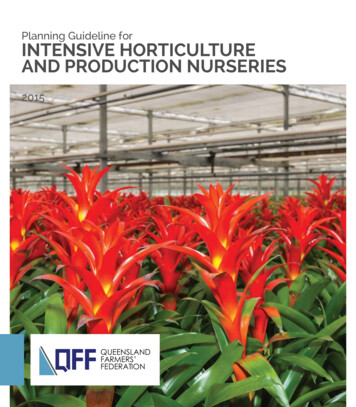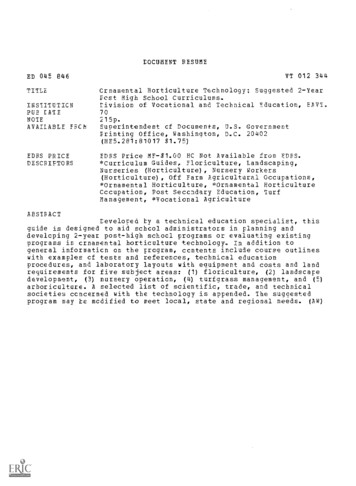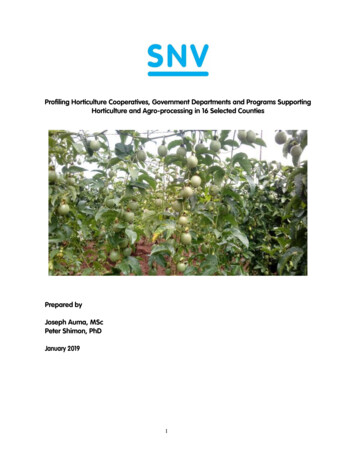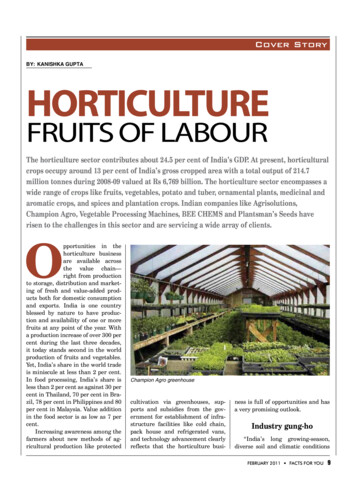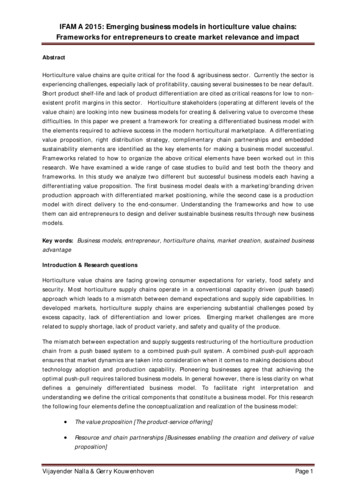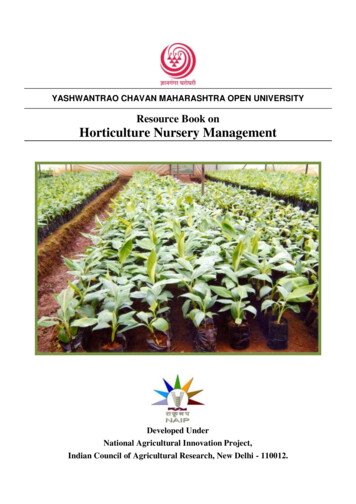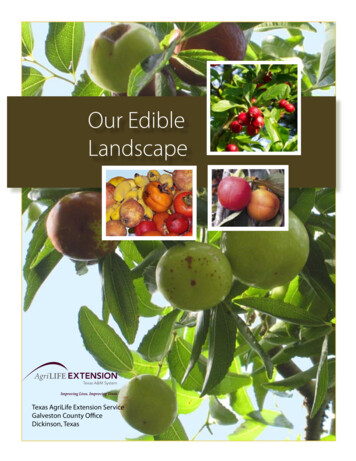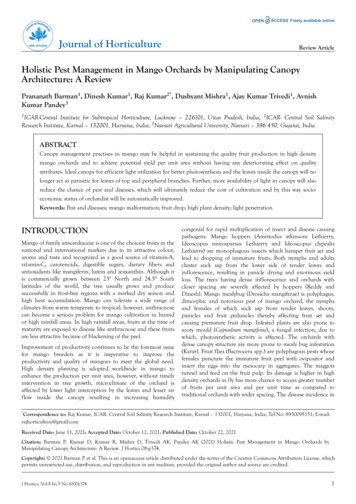
Transcription
Journal of HorticultureReview ArticleHolistic Pest Management in Mango Orchards by Manipulating CanopyArchitecture: A ReviewPrananath Barman1, Dinesh Kumar1, Raj Kumar2*, Dushyant Mishra1, Ajay Kumar Trivedi1, AvnishKumar Pandey31ICAR-CentralInstitute for Subtropical Horticulture, Lucknow – 226101, Uttar Pradesh, India; 2ICAR- Central Soil SalinityResearch Institute, Karnal – 132001, Haryana, India; 3Navsari Agricultural University, Navsari – 396 450, Gujarat, IndiaABSTRACTCanopy management practises in mango may be helpful in sustaining the quality fruit production in high densitymango orchards and to achieve potential yield per unit area without having any deteriorating effect on qualityattributes. Ideal canopy for efficient light utilization for better photosynthesis and the leaves inside the canopy will nolonger act as parasitic for leaves of top and peripheral branches. Further, more availability of light in canopy will alsoreduce the chance of pest and diseases, which will ultimately reduce the cost of cultivation and by this way socioeconomic status of orchardist will be automatically improved.Keywords: Pest and diseases; mango malformation; fruit drop; high plant density; light penetrationINTRODUCTIONMango of family anacardiaceae is one of the choicest fruits in thenational and international markets due to its attractive colour,aroma and taste and recognized as a good source of vitamin-A,vitamin-C, carotenoids, digestible sugars, dietary fibers andantioxidants like mangiferin, lutein and zeaxanthin. Although itis commercially grown between 23 North and 24.5 Southlatitudes of the world, the tree usually grows and producesuccessfully in frost-free regions with a marked dry season andhigh heat accumulation. Mango can tolerate a wide range ofclimates from warm temperate to tropical; however, anthracnosecan become a serious problem for mango cultivation in humidor high rainfall areas. In high rainfall areas, fruits at the time ofmaturity are exposed to disease like anthracnose and these fruitsare less attractive because of blackening of the peel.Improvement of productivity continues to be the foremost issuefor mango breeders as it is imperative to improve theproductivity and quality of mangoes to meet the global need.High density planting is adopted worldwide in mango toenhance the production per unit area, however, without timelyintervention in tree growth, microclimate of the orchard isaffected by lower light interception by the leaves and lesser airflow inside the canopy resulting in increasing humiditycongenial for rapid multiplication of insect and disease causingpathogens. Mango hoppers (Amritodus atkinsoni Lethierry,Ideoscopus niveosparsus Lethierry and Ideoscopus clypealisLethierry) are monophagous insects which hamper fruit set andlead to dropping of immature fruits. Both nymphs and adultscluster suck sap from the lower side of tender leaves andinflorescence, resulting in panicle drying and enormous yieldloss. The trees having dense inflorescence and orchards withcloser spacing are severely affected by hoppers (Reddy andDinesh). Mango mealybug (Drosicha mangiferae) is polyphagus,dimorphic and notorious pest of mango orchard, the nymphsand females of which suck sap from tender leaves, shoots,panicles and fruit peduncles thereby affecting fruit set andcausing premature fruit drop. Infested plants are also prone tosooty mould (Capnodium mangiferae), a fungal infection, due towhich, photosynthetic activity is affected. The orchards withdense canopy structure are more prone to mealy bug infestation(Karar). Fruit flies (Bactrocera spp.) are polyphagous pests whosefemales puncture the immature fruit peel with ovipositor andinsert the eggs into the mesocarp in aggregates. The maggotstunnel and feed on the fruit pulp. Its damage is higher in highdensity orchards as fly has more chance to access greater numberof fruits per unit area and per unit time as compared totraditional orchards with wider spacing. The disease incidence in*Correspondenceto: Raj Kumar, ICAR- Central Soil Salinity Research Institute, Karnal – 132001, Haryana, India, Tel No: 8930095151; E-mail:rajhorticulture@gmail.comReceived Date: June 11, 2021; Accepted Date: October 12, 2021; Published Date: October 22, 2021Citation: Barman P, Kumar D, Kumar R, Mishra D, Trivedi AK, Pandey AK (2021) Holistic Pest Management in Mango Orchards byManipulating Canopy Architecture: A Review. J Hortics 08:p374.Copyright: 2021 Barman P et al. This is an open-access article distributed under the terms of the Creative Commons Attribution License, whichpermits unrestricted use, distribution, and reproduction in any medium, provided the original author and source are credited.J Hortics, Vol.8 Iss.5 No:1000p3741
Kumar R et al.mango orchard is also influenced by tree spacing and canopyorientation. Powdery mildew (Oidium sp.) fungus attacks leaves,flowers and young fruits, due to which, defoliation occurs andpanicles are destroyed resuting in failure of fruit set. The diseasereduction is directly affected by increased light intensity, whichis altered by canopy architecture manipulation. Anthracnose(Colletotrichum gloeosporioides) is another fungus which isfavored by wet, humid and warm weather in the orchard withdense tree canopies. On mango panicles, symptoms are smallblack or dark-brown spots, which enlarge, coalesce and kill theflowers before production of fruits thereby reducing yield. Fruitsaffected by anthracnose develop sunken, prominent, dark brownto black decay spots before or after picking which may drop fromtrees prematurely.Therefore, tree productivity shows declining trend with theoverlapping of adjacent tree canopies, if tree vigour managementis not practiced, right from planting. And production potentialof perennial fruit tree can only be harnessed by adoption ofcanopy architecture management which involves the removal ofselected branches as well as topping to maximize lightpenetration throughout the canopy thereby reducing pestpopulation within the canopy. Besides, pesticide can be preciselyutilized for pest management in low dense canopy (Kerns). Inthis review, we shall discuss in about the holistic approach ofpest control by canopy management strategies so as to achieveand sustain the potential yield of mango in high densityorchards.Relationship between canopy architecture and pestincidenceThe distribution of pests within tree canopy is heterogeneous. Itis obvious that under higher planting density, plant canopiesoverlap into the rows, reducing light incidence on leaves,thereby making the tree canopy dense and compact whichencourage more pest and disease incidence. Observed maximumincidence of mango hoppers/inflorescence and powderymildew/ inflorescence in closer plant density of 5 m 5 m(48.10 and 0.61% more than those of 10 m 10 m, respectively),besides reducing fruit yield and total soluble solids by 43.37 and3.57%, respectively in mango cv. Kesar under Pune,Maharashtra condition (Fig. 1). Management and maintenanceof tree vigour implies finding the correct balance betweengrowth, vigorous enough to bear large fruit and to provide lightpenetration, and air circulation inside canopy for minimum pestand disease occurrence in the interior canopy. Found that thepenetration of light and spray chemicals into canopies bypruning in citrus orchard lead to a gradual reduction inamounts of dead wood in trees. They stated that dead woodholds spores of many major post-harvest pathogens, and causemechanical injures to fruit. Protection of re-growth after pruningfrom pests and diseases is necessary. Pruning makes trees easierand faster to spray, thus spray units should be recalibrated toreduce spray costs. It is advisable to revise pest managementplans to enable inside-canopy fruit and flush to be protected.Thus alteration of the population dynamic of pests is expectedfrom the manipulation of tree architecture. Beside the directeffects of branch or shoot removal as a sanitation practiceJ Hortics, Vol.8 Iss.5 No:1000p374against borers and foliar pests are involved in the success ofdirect control of pests in orchards: canopy porosity, and theorchard height and shape. Canopy architecture manipulationaffect quality of chemical spray and/or diffusion of pheromonewithin the orchard and canopy. The penetration of sprayedcompounds in the orchard canopy (i.e. particle deposition onleaf and fruit) is reported to be different according to tree totalleaf area and tree size; the deposit of the active ingredient on thetarget organs is greater in small and porous trees. However, topromote tree architecture manipulation as a control method ofinsects and diseases, research is needed on the within-tree spatialdynamics of colonization of insets and pathogens in relation totree growth pattern. Indeed, the level of insect infestation ordisease incidence and the colonization dynamics within the treeare of utmost importance to understand which categories ofshoots, leaves or fruits are more susceptible to insect and diseaseattack during the growing season and are to be manipulatedthrough tree pruning to decrease infestation rates. There is alsoa need of wide and inter-disciplinary field of research toinvestigate the relationship between architectural and chemicalaspects of the plant and insect and pathogen behaviour.Complementary experimental and modelling research on thesubject has to provide some bases to improve the knowledge onthe benefits and risks of various manipulations of treearchitecture in orchards. Thus, knowledge about tree phenology,pest and disease cycles affecting local trees and incorporation ofthis knowledge into management systems is very much essentialfor sustainable production of quality fruits in high densitymango orchards.Relationship between canopy architecture andmango malformationMango malformation caused by Fusarium mangiferae is aserious malady in mango production, occurring worldwide andcausing significant economic loss due to the general incapacityof malformed vegetative and inflorescences bearing fruits.Mango tree malformation has been attributed to a four-folddecrease in the chlorophyll levels, particularly in the chlorophylla contents in the leaves, which is decreased with an increase inthe number of malformed shoots, as reported in ‘Dashehari’mango trees under subtropical climate of Delhi. On youngseedling the disease appears at quite an early stage. Even 3-4months old plants have been found to be affected. Themalformed bunch may be at the apex or lower down at leaf axil.The seedlings produce small shoot lets bearing small scaly leaveswith a bunch like appearance on the shoot apices. Apicaldominance is lost in these seedlings and numerous vegetativebuds sprout, producing hypertrophied growth, which constitutesvegetative malformation. The multi-branching of shoot apexwith scaly leaves is misshapen and have dramatically shortenedinternodes known as “Bunchy Top”, also referred to as ‘Witch’sBroom”. Floral malformation appears in the panicles, whichimpacts fruit production since affected inflorescences usually donot set fruit. Thus, it is more serious problem than vegetativemalformation. The symptoms appear in the primary; secondaryand tertiary rachises which become short and thickened and aremuch enlarged or hypertrophied and highly branched. Suchpanicles are greener and heavier with increased crowded2
Kumar R et al.branching; possessing numerous flowers that remain unopened.Malformation increases the number of male flowers in aninflorescence and the ovary of malformed bisexual flowers isexceptionally enlarged and non-functional with poor pollenviability or either sterile or, if fertilized, eventually abort. Themechanism of fungal pathogen causing malformation may be viaroot, which completely colonize the seedling root systems andbecome systemic, spreading to apical plant tissues includingapical buds. Mango bud mite, Eriophyes mangiferae, may alsoplay an important role in the natural development ofmalformation, and is often observed in high numbers onmalformed trees. Mango malformation is highly linked withflushing pattern mango. More number of malformed paniclesemerges on triple flushes followed by double and ceased flushes.Noted that early cessation of vegetative growth favours increasedfruit production and leads to reduction of malformation ofinflorescence. It is again speculated that the emergence of moremalformed panicles on double and triple flushes could be dueto prolonged growth of these shoots, leading to depletion oftheir carbohydrate reserves, and thus to a reduced number ofsufficiently matured terminals for normal development ofpanicles (Lu). Muhammad et al. proved that older flushes(ceased flushes) attained maturity and got more blooming withlow intensity of malformation of inflorescence. Abiotic factorsdirectly or indirectly affect the incidence of the malformationdisease. Studies have revealed a correlation between abioticfactor like temperature and occurrence of mango malformationas seasonal variation in temperature at the time of floweringaffects the intensity of malformation. In north-west India thedisease is severe at 10-15 C, mild at 15-20 C, sporadic at20-25 C and nil at temperature over 25 C depending upon themean temperature during flowering (Kumar). Occurrence andseverity of the disease can be correlated with ambienttemperature at the time of flowering. As, in Egypt, the paniclesappearing in the spring shoots have been found to be mostseverely affected. Found significant effect of pruning floralmalformation in 23-25 years old high density orchards of mangocv. Amrapali, Mallika and Deashehari under subtropical climateof Delhi. The highest number of floral malformed panicles wasobserved in un-pruned trees, whereas, minimum in light prunedtrees (tip pruning of 30 shoot cm from apex). Less malformedpanicles in moderately pruned trees lead to realization of higheryield compared to un-pruned trees because later had slow growthand higher floral malformation. Severe pruning results in ahigher number of young leaves which contain higher levels ofchlorophyll a and total chlorophyll than in non-pruned treeswhich may result in a substantial reduction in floralmalformation after pruning. Annual bearing cultivar such as‘Amrapali’ exhibits lower polyphenol oxidase (PPO) activitiesand shows higher incidence of malformation compared tobiennial-bearing cultivar like ‘. Thus, PPO activity is inverselyrelated both to flowering and the incidence of malformation,and decline during fruit bud differentiation in the ‘on’-year(Sharma). PPO activities are found to be highest in severelypruned trees and lowest in lightly-pruned trees in an ‘on’-year;thus justifying an increase in pruning intensity, which result inhigher PPO activities. After pruning, mango plants may inducea self-defense mechanism by increasing the activities of bothPPO enzyme fractions. Thus, increased severity of pruning notJ Hortics, Vol.8 Iss.5 No:1000p374only minimise the incidence of malformation, but also increasePPO activities. The proline contents of malformed, non-prunedseedlings are higher than in healthy seedlings due to a higherrate of biosynthesis in malformed tissues and improvedtranslocation of amino acids from healthy to malformed tissues.The emergence of new shoots and young leaves with a lowincidence of malformation after pruning, delay senescence, butreduce proline contents. Thus, moderate pruning (60 cm fromthe shoot tip) in high-density mango orchards can be adopted torestore optimum vegetative growth and fruiting and lower theincidence of malformation in subtropics (Singh). Early removalof malformed panicles along with pruning helps to promotehealthy vegetative growth followed by emergence of normalinflorescence. During ‘on’ year, the malformation incidenceincreases due to time lag between pruning and onset offlowering and also due to increase in canopy volume. Moderatepruning of 20 cm shoot bearing malformed panicles in themonth of January at panicle emergence stage can be effective insuppressing the incidence of malformation in cv, which isusually very high in early emerging flower buds and panicles,.Pruning of shoot probably removes malformation inducingprinciple which accumulates at the shoot tip. Conventionally,affected terminals and the subtending three nodes are cut fromtrees and can be removed from the field. If these measures arepracticed for 2 or 3 consecutive years, the disease can be reducedto insignificant levels. Thereafter, the disease can be kept incheck by removing symptomatic tissues every other year. Insouth Africa, , United States and Egypt, the only controlmethod recommended commercially is the pruning of infectedbranches while in Mexico, pruning after harvest at 80 and 30cm from the affected zone maintain the lowest bud deformation.Relationship between canopy architecture and fruitdropThe worldwide production of mango is frequently reduced bysevere losses of fruit numbers throughout the growing season, aphenomenon that is referred to as premature fruit drop (Singh).Mango produces an abundance of male and polygamousflowers, but only a small proportion of the latter group issuccessfully pollinated and has the potential for setting fruit.The number of fruits per panicle at harvest stage is veryspeculative for yield estimation but it varies with the bearingbehaviour of cultivar and fruit set per panicle. Numerous bioticand abiotic factors reduce pollen viability, the fertilizationprocess of the flower, and embryo survival, which are allcommonly associated with extensive fruit drop in early season.Fruit that remains in the tree attracts a greater share of theavailable tree resources for continued growth and development.Subsequent fruit drop is induced by any factor reducingcarbohydrate availability and thus the demand of the growingfruit is not sufficiently matched by its supply. This carbohydrateimbalance can occur, for example, by air temperatures below13 C or exceeding 36 C as a result of heavily reduced leafphotosynthesis rates in dense crowded canopy of high densitymango orchards. Tree spacing has become an increasinglyimportant consideration in fruit crop production. Closer treespacing has significant effect on increase in tree height than thatof wider spacing. This is mainly due to the competition for light3
Kumar R et al.in plants at close spacing. So naturally for active photosyntheticreaction plant produce terminal branches. Similarly, increase inplant spacing result in incremental trend in stem girth whilecloser planting density causes lesser production of leaves andflowers per plant and fruit drop can also be more in closer plantspacing. This is mainly due to reduced light penetration incloser plant spacing which affects plant growth, flowering andfruit retention. Thus manipulation of tree canopy architectureby pruning improves light availability at the interior of treecanopy which thereby improve tree growth and fruit yield due toimprovement in tree photosynthetic efficiency. Insufficient pestmanagement in overcrowded dense canopy of high densityorchard can also lead to increase in fruit drop in mango.However, fruit drop can be minimized by severe pruning (tippruning of 90 cm shoot from the apex) rather than lightpruning (tip pruning of 30 cm shoot from the apex) or moderatepruning (tip pruning of 60 cm shoot from the apex) in mangobecause supply of available reserves to remaining blossoms isincreased after pruning and subsequently fruit drop decreaseswith the pruning intensity. Pruning creates vigor, which hadfavorable effect on fruit set to counteract fruit drop. Un-prunedtrees can have lower fruit set due to misbalanced ratio of growthpromoters and inhibitors, low sugar reserve in older shoots(dead, decayed and infected) and more malformed shoots.conducted a study on 15 years old senile orchard of Indiangooseberry cv Francis to convert into productivethrough canopy and nutrient management. They found that 50per cent pruning of previous season growth resulted inmaximum duration of flowering, fruit set and retention, yield,physical and chemical qualities of fruit and leaf as well as soilnutrient status. Intensity of pruning significantly affects thenumber of fruits per panicle. Fruit set is more in moderatelypruned mango trees (tip pruning of 60 cm shoot from the apex),in ‘on’ year but in ‘off’ year the maximum fruits can be observedin light pruned (tip pruning of 30 cm shoot from the apex) treeswhile the number of fruits per panicle is comparatively lesser inun-pruned trees in both ‘on’ and ‘off’ year (Singh). This isprimarily due to unavailability of adequate light and high sexratio in un-pruned trees. Thus tree pruning can be used ascanopy management strategy to reduce the fruit drop andimprove canopy yield efficiency.CONCLUSIONThe most important measures of efficiency of canopymanagement are yield of high quality fruits per unit of inputs.As population dynamics of mango pests are influenced byplanting density, tree canopy management has become a criticalcomponent of overall tree productivity which is mandatory foradequate light penetration and air flow inside the tree canopy.Thus, it is obvious that once farmers adopt high densityorcharding, formative pruning to develop proper treearchitecture and annual canopy management are to be followedregularly. If these practices are followed, the management ofpests and diseases would be very effective. As some studies onthe effect of canopy management on population dynamics ofmango pests have been conducted by some investigators,therefore, a systematic and comprehensive compilation haveJ Hortics, Vol.8 Iss.5 No:1000p374been tried to explain the effects of tree canopy architecture onholistic pest management, which will be helpful for achievinggood yield of quality fruits without relying on application of anychemicals or other extra inputs for pest control thereby reducingcost of cultivation and minimizing the damage of ecosystem.ACKNOWLEDGEMENTSWe thank ICAR Central Institute for Subtropical Horticulture,Lucknow for providing the necessary logistic support andassistance in compiling this review paper.REFERENCES1.2.3.4.5.Athani SI, and Dharmatti PR. Effect of plant density on growth andyield in banana. Karnataka J. Agric. Sci.2009; 22, 143-146.Bagchi TB, Sukul P, and Ghosh B. Biochemical changes during offseason flowering in guava (Psidium guajava L.) induced by bendingand pruning. J. Trop. Agric.2008; 46, 64-66.Bassal MA. Growth, yield and fruit quality of ‘Marisol’ clementinegrown on four rootstocks in Egypt. Sci. Hort.2009; 119(2), 132-137.Campbell CW, and Marlatt RB. Current status of mangomalformation disease in Florida. Proc. Inter. Am. Soc. Trop. Hortic.1986; 30, 223-26.Darvas JM. Control of mango blossom malformation with trunkinjection. South Afr. Mango Grow. Assoc. Year book.1987; 7, 21-24.6.Davie SJ, and Stassen PJC. Mango model: growth anddevelopment of Sensation mango trees. Acta Hort.1977; 455, 135–142.7.Dogar WA, Khan AA, Ahmed S, Tariq S, Ahmad M, Muhammad I.,Muhammad N., and Khan N. Study to determine the effects of highdensity plantation on growth and yield of citrus. Sarhad J. Agric.2017;33(2), 315-319.Ferree DC, and Schupp JR. Pruning and training physiology. InApple: Botany, Production and Uses, D.C. Ferree, and I.J.Warrington, eds. (United Kingdom: CABI).2003; pp. 319-344.FreemanS, Gamliel-Atinsky E, Maymon M, Shtienberg D, Youssef9.S, and Levin AG. Mango malformation disease: Etiology,epidemiology and management. Acta Hort.2015; 1075, 207-214.10. Gaikwad SP, Chalak SU, and Kamble AB. Effect of spacing ongrowth, yield and quality of mango. J. Krishi Vigyan.2017; 5(2),50-53.HagemannMH, Roemer MG, Kofler J, Hegele M, and Wünsche11.JN. A new approach for analyzing and interpreting data on fruitdrop in mango. HortScience.2014; 49(12), 1498-1505.8.12. Haggag WM. Mango diseases in Egypt. Agric. Biol. J. N. Am.2010;1(3), 285-289.13. Hiffny HAA, El-Barkouki M, and El-Banna GS. Morphological andphysiological aspects of the floral malformation in mangoes. EgyptianJ. Hort.1978; 5, 43-53.14. Huong PT. Some measures for rehabilitation of neglected mangoorchards in Yen Chau, Son La. J. Sci. Dev.2010; 8, 69-75.15. Karar H, Arif MJ, Ali A, Hameed A, Abbas G and Abbas Q.Assessment of yield losses and impact of morphological markers ofvarious mango (Mangiferae indica) genotypes on mango mealybug(Drosicha mangiferae Green) (Homoptera: Margarodidae).Pakistan J. Zool.2012; 44(6), 1643-1651.16. Kaur A, and Kaur N. Mango malformation: A fungal disease,physiological disorder or malady of stress. J. Appl. Nat. Sci.2018;10(1), 403-409.17. Krajewskia AJ, and Krajewski SA. Canopy management of sweetorange, grapefruit, lemon, lime and mandarin trees in the tropics:4
Kumar R et .34.35.principles, practices and commercial experiences. Acta Hort.2011;894, 65-76.Kumar J and Beniwal SPS. Mango malformation. In PlantDiseases of International Importance: Diseases of Fruit Crops,Vol. 3, J Kumar, HS Chaube, US Singh and AN Mukhopadhyay,eds. (New Jersey, USA: Prentice Hall).1992; pp. 357-393.Kumar J, Singh US, and Beniwal SPS. Mango malformation: onehundred years of research. Annu. Rev. Phytopathol.1993; 31,217-232.Kumar, P., Misra, A.K., and Modi, D.R. (2011). Current status ofmango malformation in India. Asian J. Plant Sci 10(1), 1-23.Lopez-Estrada, M.E., Noriega-Cantú, D.H., Otero-Colina, G., andGutiérrez-Reyes, G. (2005). Orchard management and sanitarypruning on the incidence of mango malformation. RevistaChapingo. Serie. horti 11, 113-120.Lu, P. (2005). Use of ethrel to eliminate late flushing and promoteflowering in mango. Paper presented at International Conferenceon Mango and Date palm: Culture and Export, June 20-23(Institute of Horticultural Sciences, Faisalabad, Pakistan).Mahrous, H.A.H. (2004). Effect of spraying some chemicalsubstances and a fungicide on floral malformation disease inmango. Acta Hort 645, 481-486.Maiti, S.C., and Sen, P.K. (1978). Studies on biennial bearing inmango III. Cessation of shoot growth and flowering. Orissa J.Hort 6, 43-51.Majumder, B.C., and Chatterjee, S.K. (1972). Biochemical studieson leaves with their ageing process in mango (Mangifera indica L.)cultivars. II: Changes of chlorophyll contents. Punjab Hort J. 12,111-115.Muhammad, F., Muhammad, I., and Muhammad, A.P. (1999).Some physiological aspects of mango malformation. Int. J. Agric.Biol 1(3), 94-96.Nasir, M.A., Aziz, A., Mohar, T.A., Ahmad, S., and Rehman, M.A.(2006). Effect of plant spacing on the growth and quality ofkinnow under Sargodha climatic conditions. Sarhad J. Agric 22,37-40.Nelson, S.C. (2008). Mango anthracnose (Colletotrichumgloeosporioides). Plant Disease, 48: 1-9.Pinero, J.C., and Prokopy, R.J. (2005). Spatial and temporalwithin-canopy distribution of egg laying by plum curculios(Coleoptera: Curculionidae) on apples in relation to tree size. J.Entomol. Sci 40, 1-9.Ploetz, R.C. (2001). Malformation: a unique and importantdisease of mango, Mangifera indica L. In Fusarium: Paul E.Nelson Memorial Symposium, B.A. Summerell, J.F. Leslie, D.Backhouse, W.L. Bryden, and L.W. Burgess, eds. (St Paul, Minn.:APS Press), pp. 233-247.Ploetz, R.C. (2004). The major diseases of mango: strategies andpotential for sustainable management. Acta Hort 645, 137-150.Ploetz, R.C., and Prakash, O. (1997). Foliar, floral and soil-bornediseases. In The Mango: Botany, Production and Uses, R.E. Litz,ed. (United Kingdom: CABI), pp. 281-326.Ploetz, R.C., Diseases of Tropical Fruit Crops (United Kingdom:CABI), 2003.Poornima, M.H., Gopali, J.B., Athani, S.I., Venkateshalu, andPatil, S. (2018). Impact of ultra high density, high density andconventional planting systems on major insect pests of mango.Journal of Entomology and Zoology Studies 6(6), 292-297.Rao, V.N.M., and Shanmugavelu, K.G. (1976). Studies on theeffect of pruning on mango. Prog. Hort 8(1), 21-28.J Hortics, Vol.8 Iss.5 No:1000p37436. Reddy, P.V.R., and Dinesh, M.R. (2005). Evaluation of 52.53.54.55.exotic collections for resistance to hopper, Idioscopus niveosparsusLethierry. Indian Journal of Plant Genetic Resources 18(1), 69-70.Schlosser, E. (1971). Mango malformation: Symptoms, occurrenceand varietal susceptibility. FAO Plant Prot. Bull 19, 12-14.Sharma, R.R., Goswami, A.M., Singh, C.N., Chhonkar, O.P., andSingh, G. (2001). Catecholase and cresolase activities and phenoliccontent in mango (Mangifera indica L.) at panicle initiation. Sci.Hortic 87, 147-151.Sharma, R.R., Singh, R., and Singh, D.B. (2006). Influence ofpruning intensity on light penetration and leaf physiology in highdensity orchards of mango trees. Fruits 61, 117-123.Shawky, I., Zidan, Z., Tomi, A.E., and Dahshan, D.I. (1980).Flowering malformation in relation to vegetative growth ofTaimour mangoes. Egyptian J. Hort 5, 123-132.Simon, S., Sauphanor, B., and Lauri, P.F. (2007). Control of fruittree pests through manipulation of tree architecture. Pest Technol1(1), 33-37.Singh, L.S., Singh, S.M., and Nirvan, R.S. (1961). Studies onmango malformation review, symptoms, extent, intensity andcause. Hort. Adv 5,197-207.Singh, P.N., and Rathore, V.S. (1983). Changes in moisturecontent, dry matter accumulation, chlorophyll and nutrientcontents in mango malformation. Indian J. Hortic 40, 21-25.Singh, R.N., Majumder, P.K., Sharma, D.K., Sinha, G.C., andBose, P.C. (1974). Effect of deblossoming on the productivity ofmango. Sci. Hortic 2, 399-403.Singh, S.K. (2007). Effect of pruning on growth, yield and fruitquality of some mango cultivars planted under high density. (PhDThesis) (New Delhi, India: Post-Graduate School, IndianAgricultural Research Institute).Singh, S.K., Singh, S.K., Sharma, R.R., and Patel, V.B. (2010).Influence of pruning intensity on flowering, fruit yields and floralmalformation in three mango cultivars planted under highdensity. Indian J. Hortic 67, 84-89.Singh, Z., and Dhill
Holistic Pest Management in Mango Orchards by Manipulating Canopy Architecture: A Review Prananath Barman1, Dinesh Kumar1, Raj Kumar2*, Dushyant Mishra1, Ajay Kumar Trivedi1, Avnish Kumar Pandey3 1ICAR-Central Institute for Subtropical Horticulture, Lucknow - 226101, Uttar Pradesh, India; 2ICAR- Central Soil Salinity Research Institute, Karnal - 132001, Haryana, India; 3Navsari .
